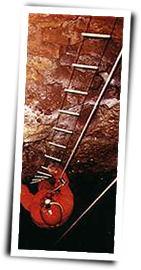

SPELEOLOGY
Without repeating the details of the history of Proumeyssac's discovery, it should be noted that after the first descent into the cave by Mr. Gallou in 1907, there was a visit on 26 July of the same year, from Mr E.A. MARTEL, the undisputed founder of speleology. To summarize the importance of this cavity, this is what he said:
"We reach the edge by car and there is a winch used for the descent. We land just 33 metres down at the top (alt.124m) of a cone of stones and debris. The bottom is shaped like an oval, approximately 600 m by 40 m; around the perimeter of the base there is an accumulation of considerable calcite deposits and beautiful concretions. In a small side room, the crystal formations, under a thin layer of water, have taken on curious triangular shapes, and specks of calcite float at the surface. We can also see helictite concretions? Which means they deviate from their normal vertical axis. In short, the visit is interesting enough to add to the one of Eyzies."

The observations of this renowned pioneer of the study of the subterranean world are accurate. The only thing we can add is that after various developments of the cavity, including the successive clearings of the lower portion of the debris-, the current depth of the cave is 42 metres. The relatively narrow, uppermost part is crossed after 10 metres of vertical depth. While the dome portion measures 32 metres. The major stalagmite formations originating from the fracture lines are situated 20 metres from the base of the pit. Lastly, we should note that a colouring of the waters seeping into the area of the rimstone or "gours", formed downstream between the debris and the wall, indicated a connection with the resurgence of Perdigat, located along the Vezere and 1500 metres as the crow flies from the opening. Precise topography of the Gouffre de Proumeyssac was carried out in 1975 by the Spéléo-Club of Périgueux.
For the sake of completeness, it should be added that the good relations that have always been maintained between the company running Proumeyssac and the cavers of Perigord, have allowed the cavers to use their techniques to preserve this remarkable underground heritage, an objective that continues to be one of the major concerns of the owners. In particular, glass markers were placed to constantly monitor the fracturing of the upper zone from the hole. Furthermore, "artificial" descents and progresses, which constituted "firsts" in the cave, were made in order to reach the main concretionary blocks and treat them using biocidal products against biological pollution.